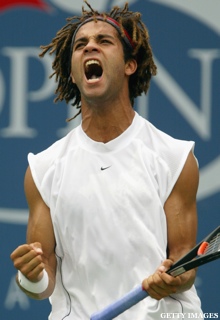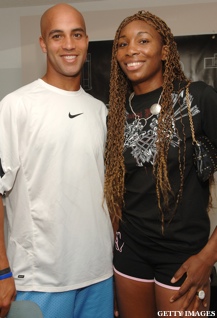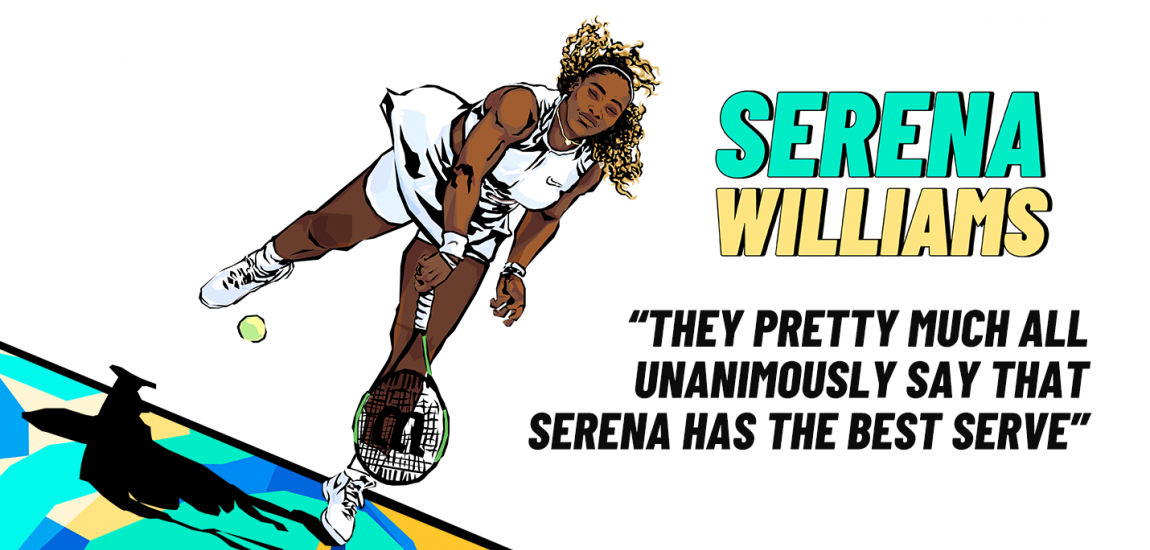NEW YORK -- James Blake entered Interview Room One at the Arthur Ashe Stadium Media Center. The wild hair is long gone and the former No. 4 has lost his intimidation factor.
No one is going to mistake Blake for one of the young stars of tennis nowadays.
But Blake held his head high. He is content where he stands. On Monday, he announced his plans to retire after his last match at the U.S. Open.

"I've had 14 pretty darn good years on tour," Blake said. "I've loved every minute of it."
The odds have always seemed against Blake. He was born to an African-American father, Tom, and a white, British mother, Betsy, in Yonkers, N.Y., on Dec. 28, 1979. At age 13 he was diagnosed with a severe case of scoliosis and spent five years in a full-length back brace 18 hours a day (As an exception, he could take it off when playing tennis).
Blake was never sent away to a tennis academy. He instead spent his youth training in the Harlem Junior Tennis program, where his parents volunteered. It was there Blake heard Arthur Ashe speak and set off the trigger for his tennis dream.
Thomas Blake, Sr. pushed his son but did not fit the stereotype of the crazy tennis father.
"He was someone that absolutely practiced what he preached and he preached hard work," Blake said of his father. "I have seen and heard about all the fathers from hell, at 12 and under, 14 and under, they're berating them for not hitting a shot the right way. He absolutely never said that. He always said you'll get better."
Blake went to Fairfield High School in Fairfield, Conn., and later Harvard University. He left Cambridge after his sophomore year to become a professional tennis player.

Blake cleared the first set of hurdles. But it was not long before he met an even bigger challenge.
In spring 2004, while practicing in Rome, Blake slipped on clay and broke his neck. His fall was inches from paralyzing him. In July of that year, Tom passed away from stomach cancer. Shortly thereafter, Blake developed shingles, temporarily leaving half his face paralyzed and his sight blurred.
"If I hadn't gotten to the ER immediately and gotten treatment, they said my facial nerve could have died," Blake recalls. "If that's the case, I never would have played."
Blake was near rock bottom. Then he made the impossible possible.
Blake put the personal and physical hardships aside and returned to action in 2005. His long-term absence and poor start to the season dropped him down to a ranking of 210 in April 2005. Blake opted to play tournaments on the Challenger Circuit, a step below the ATP Tour, to regain confidence.
Something magical happened. Blake rejoined the tour and in August, reached a final in Washington D.C. At the Pilot Pen Tournament in his backyard of New Haven, Conn., Blake won a title. He took a No. 49 ranking into the U.S. Open, of which he received a wild-card invitation. Blake reached the quarterfinals with a trip that included a win over second-ranked Rafael Nadal in the third round and ended with a loss to Andre Agassi.
"James was one of the more charismatic players on tour," Nadal said after his own three-set victory over Ryan Harrison on Monday. "His style of the game was spectacular a lot of days. He was able to play winners on the return with great first serves and his forehand was one of the best on tour."
From 2005-2008, Blake's prime included three Grand Slam quarterfinal appearances, a fourth-place finish at the Olympics and a high ranking of No. 4 in the world. During his career, he earned more than $7.8 million in prize money and ten career titles.
On paper, Blake's statistics do not rightfully portray one of the most influential men in American tennis history.
"I don't kid myself," Blake says. "I know I've had a great career in my eyes, but it's not one that's going to go down in the history books and end in Newport, but it's one that I'm proud of."

Maybe not, but maybe it will. During his prime, Blake appeared to be a player on the cusp. In that 2005 U.S. Open quarterfinal, he fell to Agassi after winning the first two sets. In his two other Grand Slam quarterfinals, he lost to Roger Federer. When Blake finally beat Federer at the quarterfinals in the 2008 Olympics (Blake is 2-10 vs. Federer, including a walkover win), he lost a three-set semifinal thriller to Fernando Gonzalez, with an 11-9 third set.
James Blake's career went beyond the court. In a world of egos and cheaters in sports, Blake took a different route.
"My goals when I was playing tennis were one, to keep getting better, to try to improve every day in practice," he said. "And two, when I'm done playing, when I put my rackets down, be content with what I did and happy I did everything the right way. That's not saying I didn't make any mistakes. I'm sure I made plenty. But I did the best of what I could. That's where I'm at today."
After her 6-1, 6-2 upset of number 12 Kirsten Flipkens, Venus Williams took time to reflect on Blake's legacy.
"I think he brought a lot of people into tennis," she said. "It's always great and also sad to lose someone who helps grow the game. People are always interested in James, so that's what I'm going to miss."
Blake fought through injuries as a teenager, 24-year-old in his prime and most recently, veteran in his 30s (Blake had knee surgery in November 2011). Every time he did not make excuses, but instead worked hard to return to form. He made himself an ally to fellow players on tour, especially the Americans. He played on Davis Cup and Olympic teams for his country.
Blake said his proudest moment was being part of the 2007 Davis Cup championship team.
"We had so many good memories," Blake said. "Even when we lost, we had fun together. Those weeks are something I'll never forget. Some of my best memories are just playing cards, shooting the breeze with those guys."

Off the court, Blake developed the Thomas Blake Sr. Memorial Research Fund with Sloan-Kettering in 2008. Blake holds fundraisers for the organization and also has the help of the "J-Block." The Blake fan club, which started with hometown friends during his 2005 New Haven title and has expanded across the nation, also contributes to the fund.
"What I admired period about him was how he gave back, obviously using his tennis career and celebrity to give back, especially to cancer because his dad passed," Williams said.
Blake's retirement does not mean the end for his mark on American tennis. His time and ears are still open to the next crop of U.S. stars.
"Hopefully younger Americans can know that my phone is always by my side, my door is always open," Blake said. "If they want to ask me questions or for any sort of advice from what I've learned, doing things the right way, the wrong way, any mistakes I've made, anything I did right. Hopefully, it will help the young American guys to learn from why I did. And know that it's not always one way. I've always said it's an individual sport. What worked for me may not work for some of these young guys."
Harrison, 21, is one of them.
"Whenever you ask anyone about James, he's left a great impression and just a great impact on everybody that he's known in the game," Harrison said. "His career is one thing. He obviously has results. I think something far more important that he's leaving behind is the fact he left a really positive impact on tennis and the people he was around."
Jamie Hampton, the 23-year-old American and the No. 23 seed in the women's draw, will remember Blake for both his on and off-the-court characteristics.
"He was good-looking," she laughed. "He could crush returns, super competitive, super fast and quick. Great forehand. He's a great guy. Everyone's going to miss him. He's had a fantastic career."
Blake's press conference was attended by his 36-year-old brother Thomas, a former player, and his wife, Emily Snider. Blake said he did not make his retirement decision on a whim. He has been thinking about it for a year and wanted to retirement at the U.S. Open in his home region. He also said spending so much time away from his family and his one-year-old daughter, Riley Elizabeth, contributed to the decision.

"I get more of adrenaline rush seeing my daughter wake up in the morning and that's something I'm truly looking forward to, being able to spend more time with my wife and daughter," Blake said as he tried to fight back tears. Then the waterworks came.
"I never expected this to happen," he said through tears.
Former player-turned-commentator Justin Gimelstob tossed Blake a towel to wipe away the tears. Family, friends, media and USTA officials applauded.
"He's one of the greatest guys out here on tour," Harrison said. "He's into the next stage of his life, which is being the family man, having the baby, having his wife and kid, just going that route."
One of the good guys of tennis is on his way out. One of the guys who Americans pulled for day-in and day-out is on his way out for good.
James Blake is OK with that. He has no regrets and has a legacy to be proud of.
"I'm going out on my own terms," he said.
He is not out yet. The 100th-ranked Blake has a date with 78th-ranked Croatian Ivo Karlovic in the first round of this week's U.S. Open. He will also be playing men's doubles with Jack Sock (Blake is ranked #61 in doubles).
"Hopefully I'll be here for more than a match or two. I want to give it my all still this year and have more of those moments."
There is no reason to not to believe him. Blake has always been one for the theatrical.
One thing is for sure. When James Blake leaves Flushing Meadows for the final time as a player, he will be a content man.
-- Follow Jeffrey Eisenband on Twitter @JeffEisenband.




